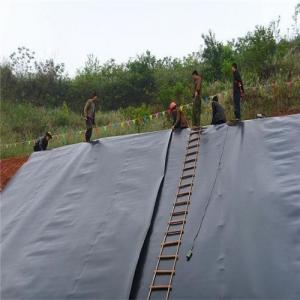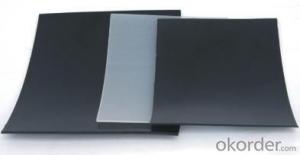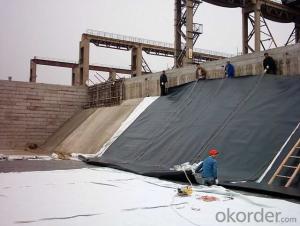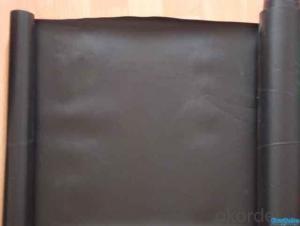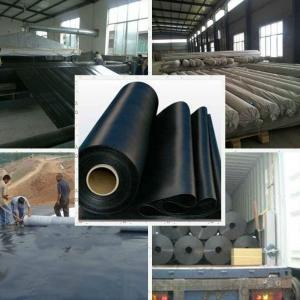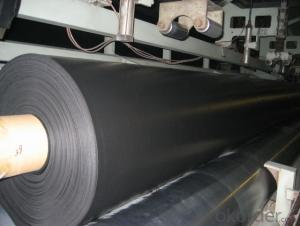2mm HDPE Geomembrane
- Loading Port:
- China Main Port
- Payment Terms:
- TT OR LC
- Min Order Qty:
- -
- Supply Capability:
- -
OKorder Service Pledge
Quality Product, Order Online Tracking, Timely Delivery
OKorder Financial Service
Credit Rating, Credit Services, Credit Purchasing
You Might Also Like
Product Overview
Geomembrane is composited with geocloth、polyethylene film and polyvinylchloride film.
It has advantages of surfacedrainage、high strength、corrosion-proof、high tearing resistance、seepage-proofing,and be widely used in the anti-seepagetreatment of the dike、railway、highway and drainage ditch, as well as in the landfill、tunnel seepage control and waterproof treatment.
Product Features
| High cost performance |
| Perfect after-sales service |
| Flexible and durable |
| Easy to transport |
| Fast delivery |
Product Specification
| Width | ≤6m |
Membrane material thickness | 0.2mm-0.8mm |
| Mass per unit | 100-800g/㎡ |
- Q: Can geomembranes be used in reservoir lining?
- Yes, geomembranes can be used in reservoir lining. Geomembranes are impermeable synthetic materials that can effectively prevent water seepage and provide a protective barrier in reservoirs. They are often used to line reservoirs to ensure water containment and prevent contamination.
- Q: Can geomembranes be used in gas containment systems?
- Yes, geomembranes can be used in gas containment systems. They are an effective barrier that can prevent the escape or leakage of gases, providing a reliable and durable solution for containing gases in various industries such as landfill sites, industrial plants, and storage facilities.
- Q: What are the most common applications for geomembranes?
- Geomembranes are commonly used in various applications such as landfill liners, pond liners, mining containment, water storage and irrigation, wastewater treatment, and oil and gas containment.
- Q: What is the water proof method of electric heating film?
- Electrothermal?film picture The material of electrothermal membrane surface is special polyester film and ink line in the middle of the diaphragm is special conductive ink, the core part of the electric heating film, equivalent to a lot of parallel resistance, can be used for heating after electrified. The silver strip on both sides of electric heating film is a metal carrier flow strip, used for connecting ink (resistance), playing an role equivalent to the wire.
- Q: Are geomembranes resistant to microbial growth?
- Yes, geomembranes are typically resistant to microbial growth. They are designed to provide a barrier against the growth and penetration of microorganisms, making them an effective solution for preventing microbial contamination in various applications such as landfill liners, agricultural ponds, and wastewater treatment facilities.
- Q: Can geomembranes be used for landfill capping?
- Yes, geomembranes can be used for landfill capping. Geomembranes are impermeable liners made from synthetic materials that can effectively contain and prevent the escape of waste materials in landfills. They are commonly used as a final cover system for landfill capping to provide a barrier against the infiltration of rainwater, leachate, and gas emissions, thus minimizing environmental impacts and protecting groundwater resources.
- Q: Are geomembranes resistant to pollution from industrial activities?
- Yes, geomembranes are specifically designed to be resistant to pollution from industrial activities. They are made from durable materials that can withstand exposure to various chemicals, oils, and other pollutants commonly found in industrial settings. This resistance helps to protect the environment by preventing the contamination of soil and groundwater.
- Q: Can all-purpose adhesive stick composite geomembrane?
- The best way to stick composite geomembrane is to weld with sweat soldering machine or monorail welding gun. If there is no such device on the construction site, you can brush PE adhesive, or use all-purpose adhesive. Brushing must be uniform, and sticking should be close and tight. Brushing surface must be kept clean without water or mud. Brushing all-purpose adhesive is relatively expensive.
- Q: What is the difference between the basement membrane and varnish?
- The biggest difference is the smell. The pungent smell of varnishes is heavy and sporadic slow, and wallpaper primer is diluted with water directly, so there is no irritating smell. The wallpaper and varnishes are membrane materials used in metope processing, using different methods and processes. Wallpaper basilemma is a new professional matching wallpaper. The textile wall covering should be made a surface treatment , it can form a dense protective layer on the wall and make the cardinal plane more sodid and durable. It is not influenced by the cardinal plane, water, humidity, and alkaline substance and cannot be powdered. It can effectively reduce the damage to the wall from water and alkaline substance. It can prevent the paper becoming yellow and increase the binding power between the wall paper and wall body and extend the using span of the wallpaper. The varnish is with a too heavy smell in the process of using, compared with the moisture can not be moisture. It will affect the consistency of wallpaper and wall, if the use of poor quality varnish will emit harmful substances.
- Q: Can geomembranes be used in underground applications?
- Yes, geomembranes can be used in underground applications. They are frequently used in applications such as lining tunnels, underground storage tanks, and landfills to prevent leakage and protect the surrounding environment.
Send your message to us
2mm HDPE Geomembrane
- Loading Port:
- China Main Port
- Payment Terms:
- TT OR LC
- Min Order Qty:
- -
- Supply Capability:
- -
OKorder Service Pledge
Quality Product, Order Online Tracking, Timely Delivery
OKorder Financial Service
Credit Rating, Credit Services, Credit Purchasing
Similar products
Hot products
Hot Searches
Related keywords













